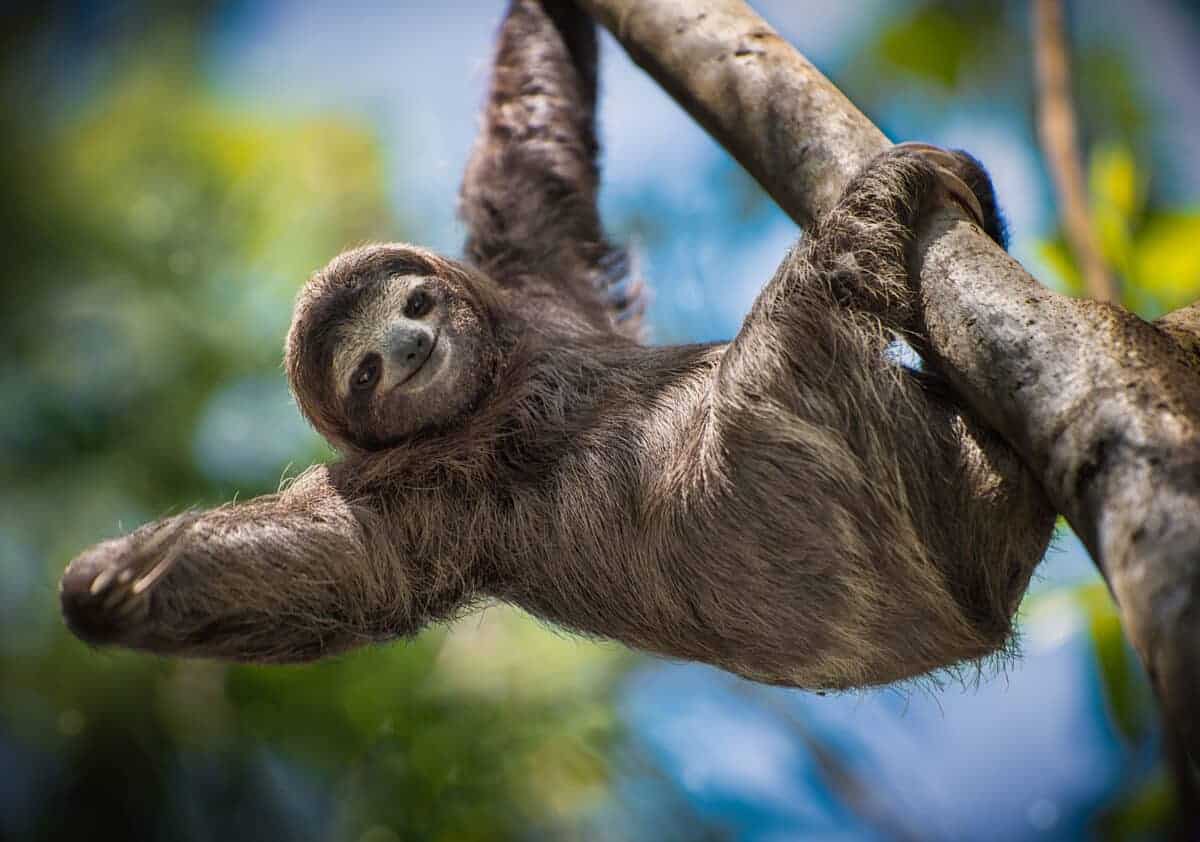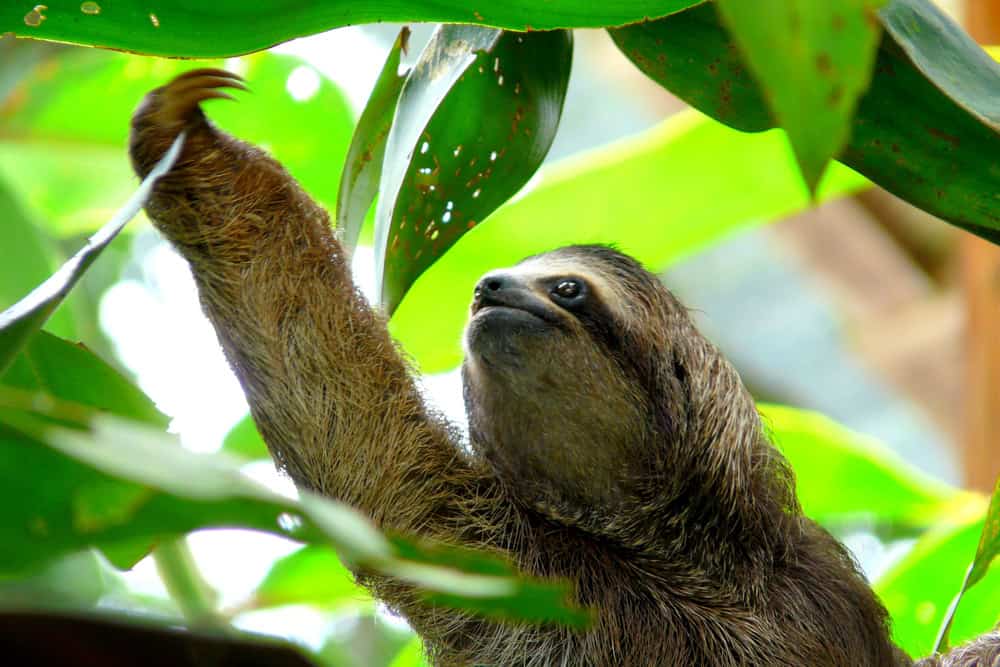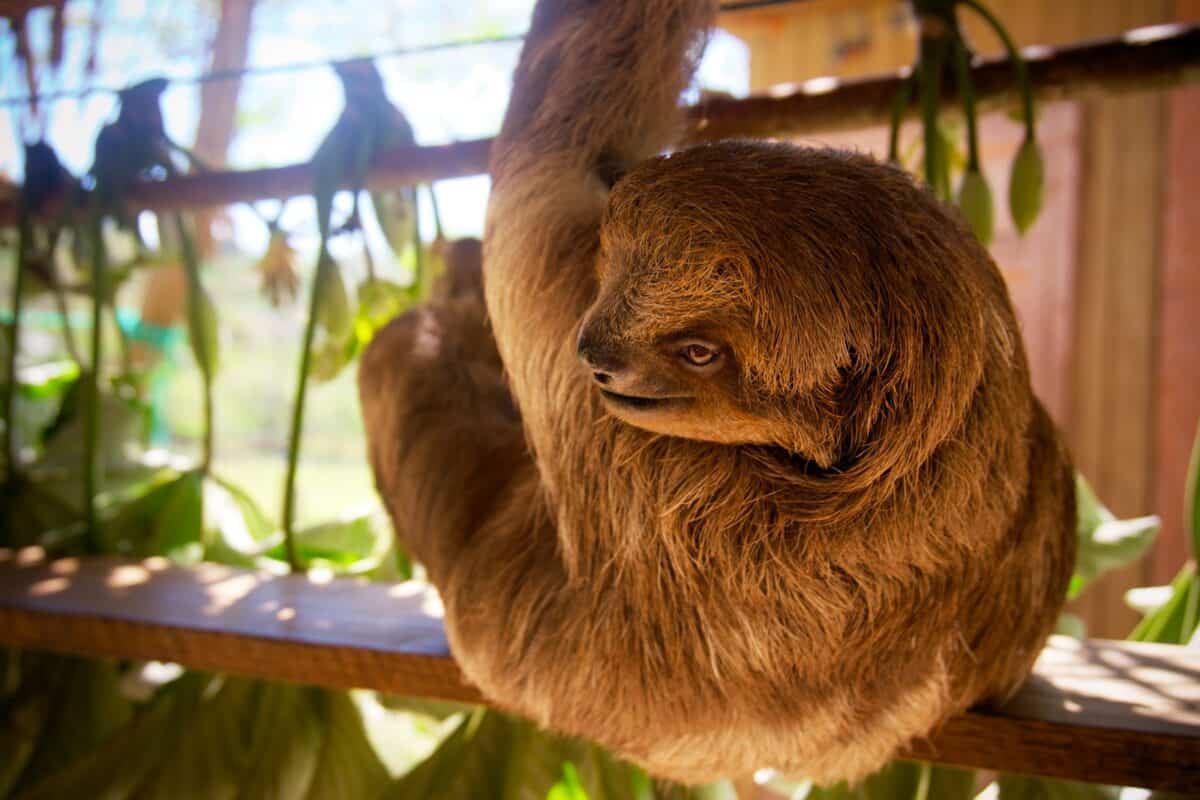Sloths, those endearing slow-moving mammals of the tropical rainforests, have captivated our hearts with their perpetual smiles and unhurried lifestyle. While they might appear similar at first glance, sloths actually fall into two distinct families: the two-toed sloths (Choloepus) and the three-toed sloths (Bradypus). Despite their similar appearances and shared reputation for being among the slowest mammals on Earth, these two types of sloths differ in numerous fascinating ways. From their anatomical structures to behavioral patterns, evolutionary histories, and even their sleeping habits, the distinctions between these gentle tree-dwellers reveal nature’s incredible diversity even among closely related species. In this comprehensive exploration, we’ll uncover 13 key differences that set two-toed and three-toed sloths apart, shedding light on these remarkable creatures that have adapted so uniquely to life in the canopies of Central and South American forests.
Anatomical Toe Differences

The most obvious difference between these two sloth families lies in their names, though it’s actually somewhat misleading. Two-toed sloths (genus Choloepus) have two digits on their forelimbs, while three-toed sloths (genus Bradypus) have three. However, both types actually have three toes on their hind limbs. The naming convention refers only to the forelimbs, which creates some confusion. This anatomical difference isn’t just a minor detail but reflects their evolutionary divergence approximately 30-40 million years ago.
These digit variations influence how each type of sloth navigates through the trees. The two-toed sloth’s forelimbs are equipped with two long, curved claws that provide excellent gripping strength for hanging from branches. Three-toed sloths, with their additional digit, distribute their weight differently and have a more symmetrical grip. These seemingly small anatomical differences translate to distinct movement patterns and capabilities in their arboreal habitat, demonstrating how evolution has shaped these creatures to thrive in similar yet specialized ecological niches.
Size and Weight Distinctions

Two-toed sloths are generally larger and heavier than their three-toed counterparts. On average, two-toed sloths weigh between 12-20 pounds (5.4-9 kg) and can reach lengths of approximately 24-30 inches (60-75 cm). Their more robust build gives them a somewhat stockier appearance compared to the more delicate-looking three-toed sloths. This size difference affects everything from their metabolic requirements to their movement capabilities and predator vulnerability.
Three-toed sloths are notably smaller, typically weighing between 8-10 pounds (3.6-4.5 kg) and measuring about 20-24 inches (50-60 cm) in length. Their smaller size correlates with their slower metabolic rate and contributes to their reputation as being even more languid than their two-toed relatives. These physical differences aren’t merely superficial but reflect deeper adaptations to slightly different ecological strategies within the tropical forest canopy, including dietary specialization and energy conservation approaches that have evolved over millions of years.
Facial and Skull Features

The facial features of these two sloth types offer some of the most distinguishable visual differences. Three-toed sloths possess a distinctive facial pattern that looks like a perpetual smile, with dark markings around their eyes that create a mask-like appearance. Their faces appear rounder and more compact, with a shorter snout. Their most endearing feature might be what appears to be a constant smile, which has contributed significantly to their popularity in media and wildlife photography. Their skulls are more rounded and have a less pronounced snout structure.
Two-toed sloths have longer, more protruding snouts and lack the distinctive facial markings of their three-toed relatives. Their faces appear more elongated and pig-like, with a more pronounced nose. Their skull structure is more elongated to accommodate their different dental arrangement, which reflects their less specialized diet. Two-toed sloths also have darker fur around their eyes and faces, but the pattern doesn’t create the same “smiling mask” effect that makes three-toed sloths so instantly recognizable to human observers.
Dietary Preferences

The dietary habits of these two sloth types reflect significant adaptational differences. Three-toed sloths are highly specialized folivores, meaning they eat almost exclusively leaves, particularly from Cecropia trees. This specialized diet contributes to their extremely slow digestion and metabolism, as leaves provide relatively little nutritional value and contain compounds that can be toxic if consumed in large quantities. Their specialized stomachs have multiple chambers and host symbiotic bacteria that help break down the tough cellulose in leaves, a process that can take up to a month for complete digestion.
Two-toed sloths display more dietary flexibility as omnivores. While leaves still constitute a significant portion of their diet, they also consume fruits, small shoots, insects, and occasionally small vertebrates. This broader dietary range requires different digestive adaptations and may contribute to their relatively more active lifestyle compared to three-toed sloths. Their less specialized diet also means they aren’t as dependent on specific tree species, potentially giving them more flexibility in habitat selection and making them somewhat more adaptable to forest changes than their three-toed relatives.
Speed and Activity Patterns

While both sloth types are famously slow-moving animals, there are noticeable differences in their activity levels and speeds. Three-toed sloths are the slower of the two, moving at an average pace of about 0.15 miles per hour (0.24 km/h). This extraordinarily leisurely pace is directly linked to their extremely low metabolic rate, which is among the slowest of any mammal on Earth. They are almost exclusively diurnal (active during daylight hours), unlike most nocturnal rainforest mammals, which is thought to be related to their need for sunshine to help regulate their body temperature.
Two-toed sloths, while still slow by most mammalian standards, can move nearly twice as fast as three-toed sloths, reaching speeds of about 0.25 miles per hour (0.4 km/h). They are primarily nocturnal, becoming active during evening hours to feed and move between trees. This nocturnal activity pattern may provide protection from visual predators like harpy eagles and gives them a different ecological niche than three-toed sloths, allowing both types to coexist in the same forests without direct competition. Two-toed sloths also tend to cover more territory over time, which correlates with their more varied diet and need to find diverse food sources.
Sleeping Habits and Postures

Sleep occupies a significant portion of sloth life, but the two types have developed different sleeping habits and postures. Three-toed sloths typically sleep curled into a ball in the fork of tree branches, often with their head tucked between their arms. This position provides stability and helps conserve body heat. They sleep approximately 15-18 hours per day, waking primarily to feed and occasionally to descend to the forest floor for defecation. Their sleeping position in the trees often integrates them perfectly into the canopy, making them nearly invisible to predators and human observers alike.
Two-toed sloths prefer to sleep hanging completely upside down from branches, using their strong hooked claws to maintain a secure grip even while in deep sleep. This distinctive posture is made possible by their muscular adaptation and specialized circulatory system that prevents blood from rushing to their heads. They typically sleep around 16-20 hours daily, slightly more than three-toed sloths, and are more likely to change sleeping locations regularly. This mobility, even with their extensive sleep requirements, reflects their broader territory range and diverse feeding habits compared to the more stationary three-toed sloths.
Fur Characteristics and Camouflage

The fur of these two sloth types differs significantly in structure and function. Three-toed sloths have deeply grooved hair that encourages the growth of symbiotic algae, giving them a greenish tint during wet seasons. This remarkable adaptation provides excellent camouflage in the rainforest canopy and may even supplement their nutrition when they groom themselves. Their fur grows in the opposite direction from most mammals – from belly to back rather than back to belly – which helps water run off their bodies as they hang upside down during rainstorms. Each hair has cracks that serve as a habitat for various insects and algae, creating a mini-ecosystem.
Two-toed sloths have longer, shaggier fur that tends to be brown or grayish-brown without the pronounced green tint of their three-toed cousins. While they also host algae and small invertebrates in their fur, the relationship is not as developed as in three-toed sloths. Their fur provides excellent insulation and water resistance but serves less as a camouflage mechanism. The differences in fur characteristics between the two types reflect their different evolutionary strategies, with three-toed sloths developing more specialized relationships with other organisms as part of their extreme energy conservation lifestyle.
Reproductive Differences

Reproduction in sloths is as unhurried as their general lifestyle, but there are notable differences between the two types. Three-toed sloths typically give birth to a single baby after a gestation period of approximately 5-6 months. Females reach sexual maturity around 3 years of age and generally reproduce once per year. They are solitary animals that come together only briefly for mating, with females making a specialized vocalization to attract males during estrus. Mother-infant bonds are strong, with young sloths clinging to their mother’s belly for the first 5-6 months of life before beginning independence.
Two-toed sloths have a significantly longer gestation period of 7-10 months and may not reproduce every year. Their reproductive cycle appears to be less seasonal than that of three-toed sloths, with births occurring throughout the year depending on environmental conditions. Young two-toed sloths remain dependent on their mothers for approximately 6-9 months, longer than three-toed sloths, reflecting their more complex dietary needs and behaviors that must be learned. The different reproductive strategies align with their overall life history patterns, with three-toed sloths adopting an extremely specialized, energy-efficient approach and two-toed sloths displaying somewhat more flexibility.
Evolutionary History

The evolutionary paths of two-toed and three-toed sloths represent a fascinating case of convergent evolution. Despite their similarities, these two sloth types are not closely related and evolved their tree-dwelling, slow-moving lifestyles independently. Three-toed sloths (family Bradypodidae) are considered more ancient, having diverged earlier in the evolutionary history of xenarthrans (the mammalian group that includes sloths, anteaters, and armadillos). Fossil evidence suggests they have maintained a similar body plan for millions of years, representing one of the most specialized mammalian adaptations.
Two-toed sloths (family Megalonychidae) are more closely related to extinct ground sloths than to three-toed sloths. Their family once included various ground-dwelling species, some reaching the size of elephants during the Pleistocene epoch. Modern two-toed sloths represent the smaller, tree-adapted survivors of this once diverse family. This separate evolutionary origin explains many of the fundamental differences between the two types, from their anatomical structures to their behavioral patterns. Their similar appearances and lifestyles constitute one of nature’s most remarkable examples of convergent evolution, where unrelated organisms develop similar traits in response to comparable environmental pressures.
Geographic Distribution

The geographic distributions of two-toed and three-toed sloths overlap in some regions but show distinctive patterns. Three-toed sloths are found exclusively in the neotropical rainforests of Central and South America, ranging from Honduras in the north to northern Argentina and southern Brazil in the south. They are divided into four species, each with specific regional distributions: the brown-throated sloth (most widespread), the pale-throated sloth (northeastern South America), the maned sloth (Atlantic coastal forest of Brazil), and the pygmy three-toed sloth (isolated on a small island off Panama).
Two-toed sloths have a somewhat broader distribution, occurring throughout Central America and northern South America, including areas of Venezuela, Colombia, Ecuador, Peru, and Brazil. They comprise two species: Linnaeus’s two-toed sloth (more widespread across northern South America) and Hoffmann’s two-toed sloth (Central America and northwestern South America). Two-toed sloths tend to inhabit a wider range of forest types, including both primary rainforests and more disturbed secondary forests, reflecting their greater dietary flexibility compared to the more specialized three-toed sloths, which are typically restricted to primary forest habitats with specific tree species.
Defense Mechanisms

Despite their vulnerable appearance, sloths have evolved different mechanisms to protect themselves from predators. Three-toed sloths rely almost exclusively on camouflage as their primary defense strategy. Their cryptic coloration, enhanced by algae growing in their fur, makes them nearly invisible among the foliage. When threatened, they remain motionless, blending perfectly with their surroundings. They have very little muscle mass dedicated to movement, making rapid escape impossible, so their evolutionary strategy has focused on not being detected in the first place. Their extreme energy conservation approach means they produce minimal body heat and have little scent, making them difficult for predators to detect.
Two-toed sloths, while still masters of camouflage, have developed additional defensive capabilities. They possess relatively stronger limbs and can swipe at predators with their sharp claws when threatened. They are also known to bite, with powerful jaw muscles and sharp teeth that can inflict significant damage. Two-toed sloths are more likely to actively defend themselves when cornered, whereas three-toed sloths almost never display aggressive behaviors. These different defensive strategies reflect their divergent evolutionary paths, with two-toed sloths retaining more of the active defense mechanisms of their ground sloth ancestors while three-toed sloths have evolved toward extreme specialization in passive defense through camouflage and energy conservation.
Lifespan and Aging

The lifespans of these fascinating creatures reflect their slow-paced lifestyle and low metabolic rates. Three-toed sloths typically live 20-30 years in the wild, with some individuals in protected environments reaching up to 40 years. Their extremely specialized lifestyle, with minimal energy expenditure and very low metabolic rates, contributes to their longevity despite their relatively small size. Their aging process appears to be gradual, with few outward signs until the very late stages of life. Their specialized digestive system and teeth can become less efficient with age, eventually leading to nutritional challenges.
Two-toed sloths generally have similar lifespans, ranging from 20-30 years in wild conditions and potentially longer in captivity, with some documented cases exceeding 40 years. Their slightly higher metabolism and more varied diet may create different patterns of age-related changes compared to three-toed sloths. Both sloth types demonstrate remarkably slow senescence (biological aging) compared to mammals of similar size, which aligns with their overall slow pace of life. This characteristic makes them valuable subjects for longevity research, as understanding the mechanisms behind their slow aging might provide insights relevant to human age-related conditions.
Conservation Status and Threats

The conservation status varies significantly between different sloth species within both types. Among three-toed sloths, the pygmy three-toed sloth is critically endangered, with fewer than 100 individuals remaining in the wild on Isla Escudo de Veraguas off Panama. The maned three-toed sloth is vulnerable due to the destruction of Brazil’s Atlantic Forest. The more common brown-throated and pale-throated three-toed sloths are currently listed as least concern, though their populations are declining due to habitat loss. Three-toed sloths are particularly vulnerable to deforestation due to their specialized diet and inability to adapt to fragmented habitats.
Two-toed sloth species are generally categorized as least concern on the IUCN Red List, but this status masks declining populations across much.
Conclusion:

Two-toed and three-toed sloths may share a slow-paced lifestyle and arboreal habitat, but a closer look reveals a fascinating world of differences shaped by millions of years of separate evolution. From the number of digits on their forelimbs to variations in diet, sleep patterns, reproductive strategies, and even their fur and facial features, each species has adapted uniquely to the challenges of life in the rainforest canopy. These differences are not just superficial—they reflect distinct evolutionary paths that have allowed both sloth types to thrive in overlapping but specialized ecological niches.
Understanding the 13 key distinctions between two-toed and three-toed sloths not only deepens our appreciation for these gentle creatures but also highlights the complexity and diversity of life in tropical ecosystems. As we learn more about their biology, behavior, and conservation needs, we are reminded of the importance of preserving the rich habitats that support such uniquely adapted animals. In a rapidly changing world, sloths serve as a quiet but powerful symbol of the beauty and fragility of our natural heritage.
- The Most Beautiful Bird Migration Routes Across the US - August 9, 2025
- 14 Dog Breeds That Love to Cuddle - August 9, 2025
- 11 Signs Your Horse Might Be Bored - August 9, 2025

